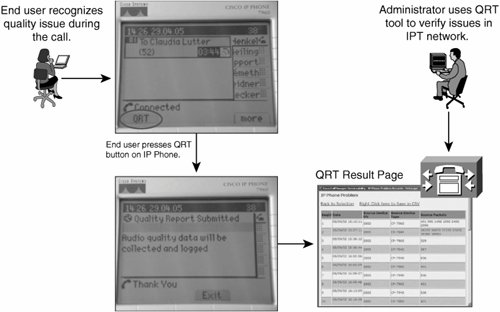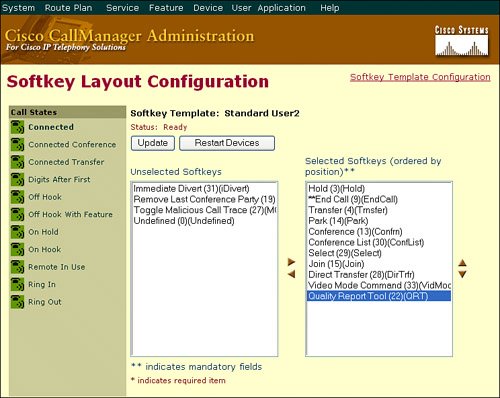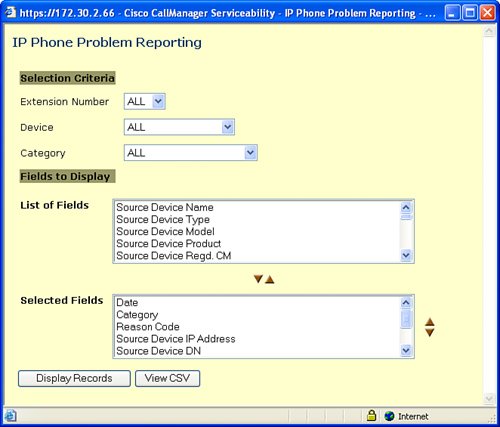Understanding Cisco Unified CallManager
Quality Report Tool
QRT is a voice-quality and general problem-reporting tool for Cisco CallManager IP Phones. The Cisco Extended Functions service supports the QRT feature. The QRT Viewer, located in the Tools menu of Cisco CallManager Serviceability, allows administrators to filter, format, and view problem reports that are generated.
Administrators can configure Cisco IP Phones with QRT, which is installed as part of the Cisco CallManager installation, so that users can report problems with IP phone calls. Users report issues by using a Cisco IP Phone softkey that is labeled QRT. Any Cisco IP Phone that supports an HTTP web server also includes support for QRT. The IP phone must be in the Connected, Connected Conference, Connected Transfer, or On Hook state for the QRT softkey to be available.
QRT is a feature that extends to Cisco IP Phones as a Microsoft Windows NT service. Cisco Extended Functions, which supports the QRT feature, must be enabled in the Cisco CallManager service activation window. To enable Cisco Extended Functions, choose Cisco CallManager Serviceability > Tools > Service Activation and activate the service called Cisco Extended Functions.
When a user presses the QRT softkey, as shown in Figure 34-11, QRT displays a feedback window. It is possible that while the user is interacting with the QRT screen, another application, such as Cisco Call Back or Cisco IP Manager Assistant (IPMA), or function keys, such as settings, directories, messages, and so on, could overwrite the QRT screen. In this situation, QRT cannot send the feedback. To send feedback in such cases, the user has to press the QRT softkey again.
Figure 34-11. QRT Submission Process

If a user presses the QRT softkey to generate a report and forgets to stop the logging process (the user must manually stop the logging process by pressing the End softkey on the Cisco IP Phone), the QRT tool periodically checks all IP phones that are generating reports and closes them. This action prevents the device from consuming large amounts of resources that, over time, could impact CTI performance. Currently, the default setting is to check every hour and to close devices that have remained open for more than an hour.
QRT records are written only when the end user presses the QRT softkey on the IP phone, selects a problem, and sends the report to the administrator. Otherwise, no records are written and the administrator cannot troubleshoot the problem. The figure shows the logging process of an audio call between two IP phones.
Depending on how the system administrator configured QRT for the Cisco IP Phone, users can use the QRT softkey in either of the two ways described in Table 34-4.
|
Issue |
What To Do |
|---|---|
|
To quickly report an audio problem with a current call while on a call, press More > QRT. |
Your IP phone system will collect and log call data for the current call and route this information to your system administrator. |
|
To report a problem with your phone calls, press More > QRT. |
Select the problem that you want to report from the list of problem categories. Some problem categories include a reason code that you can select to provide more details about the problem. Your IP phone system will store the information in a database or file and the administrator can run reports to diagnose the problem. |
Activating the QRT Softkey
The system administrator can temporarily configure a Cisco IP Phone with QRT to troubleshoot problems with calls. Reconfigure the softkey layout for the IP phone (choose Cisco CallManager Administration > Device > Device Settings > Softkey Template > softkey_template_name > Softkey Layout) to activate the QRT softkey, as shown in Figure 34-12. Users can now report problems by using the QRT softkey during or after a call.
Figure 34-12. Adding the QRT Softkey

When the administrator modifies the softkey templates to activate the QRT softkey, the softkey should be added to the following call states:
- Connected
- Connected Conference
- Connected Transfer
- On Hook
Viewing QRT Logs
Administrators can view the IP phone problem reports that are generated by QRT by using QRT Viewer.
Note
QRT collects streaming data only once per call. Therefore, if user A calls user B and both submit reports for that call, only the first report includes streaming data (for example, delay, jitter, and ports being used).
Use the following steps to view the QRT logs:
|
Step 1. |
To open the IP phone Problem Reporting window, choose Cisco CallManager Serviceability > Tools > QRT Viewer. |
|
Step 2. |
Choose the Cisco CallManager server for which you want to view a problem report. Enter a start and end date in the Date fields. In the Time fields, you can specify the time for those dates, if needed. An illustration of this is shown in Figure 34-13. Figure 34-13. Generating a QRT Query: Time and Date Fields 
|
|
Step 3. |
Click the Get Logs button. |
|
Step 4. |
From the Extension Number, Device, and Category drop-down menus, choose the extension numbers, the devices, and the problem categories that you want to include in the report, as shown in Figure 34-14. Figure 34-14. Generating a QRT Query: IP Phone Filters 
|
|
Step 5. |
From the List of Fields drop-down menu, select the fields that you want to include in the report and click the down arrow to move the selected fields to the Selected Fields pane. |
The QRT output displays all IP phone problems for the specified time frame. For the filters set in the query, all issues within the time frame are displayed. In Figure 34-15, two QRT reports matched the submitted query. One of the QRT reports came from extension 4015 and the other from extension 4010.
Figure 34-15. QRT Report Sample

When you choose All from the Category field, all problems are displayed. The Category and Reason Code columns are the areas that you should look at first. These two columns describe the problem and the reason. The output can be saved in a Comma-Separated Values (CSV) file.
Note
Because QRT reports are based only on entries in the QRT database and records are added to that database only if a user presses the QRT softkey, QRT cannot detect any problems on its own; it relies completely on user activity.
Part I: Cisco CallManager Fundamentals
Introduction to Cisco Unified Communications and Cisco Unified CallManager
- Cisco Unified Communications
- Understanding Cisco Unified CallManager
- Summary
- Review Questions
Cisco Unified CallManager Clustering and Deployment Options
- Cisco Unified CallManager Clustering and Deployment Options
- The Two Sides of the Cisco Unified CallManager Cluster
- Cluster Redundancy Designs
- Call-Processing Deployment Models
- Summary
- Review Questions
Cisco Unified CallManager Installation and Upgrades
- Cisco Unified CallManager Installation and Upgrades
- Cisco Unified CallManager 4.x Clean Installation Process
- Upgrading Prior Cisco Unified CallManager Versions
- Summary
- Review Questions
Part II: IPT Devices and Users
Cisco IP Phones and Other User Devices
Configuring Cisco Unified CallManager to Support IP Phones
- Configuring Cisco Unified CallManager to Support IP Phones
- Configuring Intracluster IP Phone Communication
- IP Phone Configuration
- Case Study: Device Pool Design
- Summary
- Review Questions
Cisco IP Telephony Users
- Cisco IP Telephony Users
- Cisco CallManager User Database
- Cisco CallManager User Configuration
- User Logon and Device Configuration
- Summary
- Review Questions
Cisco Bulk Administration Tool
- Cisco Bulk Administration Tool
- The Cisco Bulk Administration Tool
- Using the Tool for Auto-Registered Phone Support
- Summary
- Review Questions
Part III: IPT Network Integration and Route Plan
Cisco Catalyst Switches
- Cisco Catalyst Switches
- Catalyst Switch Role in IP Telephony
- Powering the Cisco IP Phone
- Data and Voice VLANs
- Configuring Class of Service
- Summary
- Review Questions
Configuring Cisco Gateways and Trunks
- Configuring Cisco Gateways and Trunks
- Cisco Gateway Concepts
- Configuring Access Gateways
- Cisco Trunk Concepts
- Configuring Intercluster Trunks
- SIP and Cisco CallManager
- Summary
- Review Questions
Cisco Unified CallManager Route Plan Basics
- Cisco Unified CallManager Route Plan Basics
- External Call Routing
- Route Plan Configuration Process
- Summary
- Review Questions
Cisco Unified CallManager Advanced Route Plans
- Cisco Unified CallManager Advanced Route Plans
- Route Filters
- Discard Digit Instructions
- Transformation Masks
- Translation Patterns
- Route Plan Report
- Summary
- Review Questions
Configuring Hunt Groups and Call Coverage
- Configuring Hunt Groups and Call Coverage
- Call Distribution Components
- Configuring Line Groups, Hunt Lists, and Hunt Pilots
- Summary
- Review Questions
Implementing Telephony Call Restrictions and Control
- Implementing Telephony Call Restrictions and Control
- Class of Service Overview
- Partitions and Calling Search Spaces Overview
- Time-of-Day Routing Overview
- Configuring Time-of-Day Routing
- Time-of-Day Routing Usage Scenario
- Summary
- Review Questions
Implementing Multiple-Site Deployments
- Implementing Multiple-Site Deployments
- Call Admission Control
- Survivable Remote Site Telephony
- Summary
- Review Questions
Part IV: VoIP Features
Media Resources
- Media Resources
- Introduction to Media Resources
- Conference Bridge Resources
- Media Termination Point Resources
- Annunciator Resources
- Transcoder Resources
- Music on Hold Resources
- Media Resource Management
- Summary
- Review Questions
Configuring User Features, Part 1
- Configuring User Features, Part 1
- Basic IP Phone Features
- Softkey Templates
- Enhanced IP Phone Features
- Barge and Privacy
- IP Phone Services
- Summary
- Review Questions
Configuring User Features, Part 2
- Configuring User Features, Part 2
- Cisco CallManager Extension Mobility
- Client Matter Codes and Forced Authentication Codes
- Call Display Restrictions
- Malicious Call Identification
- Multilevel Precedence and Preemption
- Summary
- Review Questions
Configuring Cisco Unified CallManager Attendant Console
- Configuring Cisco Unified CallManager Attendant Console
- Introduction to Cisco CallManager Attendant Console
- Call Routing and Call Queuing
- Server and Administration Configuration
- Cisco Attendant Console Features
- Summary
- Review Questions
Configuring Cisco IP Manager Assistant
- Configuring Cisco IP Manager Assistant
- Cisco IP Manager Assistant Overview
- Cisco IP Manager Assistant Architecture
- Configuring Cisco IPMA for Shared-Line Support
- Summary
- Review Questions
Part V: IPT Security
Securing the Windows Operating System
- Securing the Windows Operating System
- Threats Targeting the Operating System
- Security and Hot Fix Policy
- Operating System Hardening
- Antivirus Protection
- Cisco Security Agent
- Administrator Password Policy
- Common Windows Exploits
- Security Taboos
- Summary
- Review Questions
Securing Cisco Unified CallManager Administration
- Securing Cisco Unified CallManager Administration
- Threats Targeting Remote Administration
- Securing CallManager Communications Using HTTPS
- Multilevel Administration
- Summary
- Review Questions
Preventing Toll Fraud
- Preventing Toll Fraud
- Toll Fraud Exploits
- Preventing Call Forward and Voice-Mail Toll Fraud Using Calling Search Spaces
- Blocking Commonly Exploited Area Codes
- Using Time-of-Day Routing
- Using FAC and CMC
- Restricting External Transfers
- Dropping Conference Calls
- Summary
- Review Questions
Hardening the IP Phone
Understanding Cryptographic Fundamentals
- Understanding Cryptographic Fundamentals
- What Is Cryptography?
- Symmetric Encryption
- Asymmetric Encryption
- Hash Functions
- Digital Signatures
- Summary
- Review Questions
Understanding the Public Key Infrastructure
- Understanding the Public Key Infrastructure
- The Need for a PKI
- PKI as a Trusted Third-Party Protocol
- PKI Entities
- PKI Enrollment
- PKI Revocation and Key Storage
- PKI Example
- Summary
- Review Questions
Understanding Cisco IP Telephony Authentication and Encryption Fundamentals
- Understanding Cisco IP Telephony Authentication and Encryption Fundamentals
- Threats Targeting the IP Telephony System
- How CallManager Protects Against Threats
- PKI Topologies in Cisco IP Telephony
- PKI Enrollment in Cisco IP Telephony
- Keys and Certificate Storage in Cisco IP Telephony
- Authentication and Integrity
- Encryption
- Summary
- Review Questions
Configuring Cisco IP Telephony Authentication and Encryption
- Configuring Cisco IP Telephony Authentication and Encryption
- Authentication and Encryption Configuration Overview
- Enabling Services Required for Security
- Using the CTL Client
- Working with Locally Significant Certificates
- Configuring the Device Security Mode
- Negotiating Device Security Mode
- Generating a CAPF Report
- Summary
- Review Questions
Part VI: IP Video
Introducing IP Video Telephony
- Introducing IP Video Telephony
- IP Video Telephony Solution Components
- Video Call Concepts
- Video Protocols Supported in Cisco CallManager
- Bandwidth Management
- Call Admission Control Within a Cluster
- Call Admission Control Between Clusters
- Summary
- Review Questions
Configuring Cisco VT Advantage
- Configuring Cisco VT Advantage
- Cisco VT Advantage Overview
- How Calls Work with Cisco VT Advantage
- Configuring Cisco CallManager for Video
- Configuring Cisco IP Phones for Cisco VT Advantage
- Installing Cisco VT Advantage on a Client
- Summary
- Review Questions
Part VII: IPT Management
Introducing Database Tools and Cisco Unified CallManager Serviceability
- Introducing Database Tools and Cisco Unified CallManager Serviceability
- Database Management Tools
- Cisco CallManager Serviceability Overview
- Tools Overview
- Summary
- Review Questions
Monitoring Performance
- Monitoring Performance
- Performance Counters
- Microsoft Event Viewer
- Microsoft Performance Monitor
- Real-Time Monitoring Tool Overview
- Summary
- Review Questions
Configuring Alarms and Traces
- Configuring Alarms and Traces
- Alarm Overview
- Alarm Configuration
- Trace Configuration
- Trace Analysis
- Trace Collection
- Bulk Trace Analysis
- Additional Trace Tools
- Summary
- Review Questions
Configuring CAR
- Configuring CAR
- CAR Overview
- CAR Configuration
- Report Scheduling
- System Database Configuration
- User Report Configuration
- Summary
- Review Questions
Using Additional Management and Monitoring Tools
- Using Additional Management and Monitoring Tools
- Remote Management Tools
- Dependency Records
- Password Changer Tool
- Cisco Dialed Number Analyzer
- Quality Report Tool
- Summary
- Review Questions
Part VIII: Appendix
Appendix A. Answers to Review Questions
Index
EAN: 2147483647
Pages: 329
